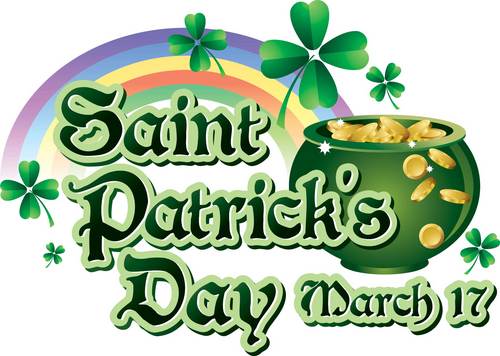Saint Patrick’s Day
Why do we wear green on St. Patrick’s Day?
Traditionally, the color green represents Ireland, or the Emerald Isle. However,
according to legend the color green also has the magical power to
make people invisible to leprechauns or other fairy creatures. That means
that wearing green can save you from getting pinched by these mischievous
fairies. If you don’t wear green on St. Patrick’s Day, watch out!
Why shamrocks?
In ancient Ireland a shamrock was a symbol of the rebirth of spring, and
was considered a sacred plant. In the 1600s the shamrock became a symbol
of Irish nationalism. During the time when the English were invading Irish
land, people would wear shamrocks as a symbol of their heritage.
Where did the leprechaun come from?
The “lobaircin”, or leprechaun, most likely originated from Celtic folklore
and their belief in fairies— tiny men and women who had magical powers,
used for both good and evil. In Celtic tales, leprechauns were the ones who
mended shoes for other fairies. They were grumpy and mean-spirited, and
best known for their trickery. The leprechaun was never a symbol of St.
Patrick’s Day, but in 1959 a Disney film was released that transformed the
leprechaun’s image into that of a cheery, good-hearted soul.
Who is Saint Patrick?
St. Patrick is the patron saint of Ireland, although he was actually born in
England. As a youth he was taken prisoner by the Irish and held in captivity
there for six years. During that time he became a devout Christian. It
is said that he heard God’s voice, which helped him escape captivity, and
that later he had visions of an angel, who told him to return to Ireland as a
missionary. It is widely believed that Patrick was the one who introduced
Christianity to Ireland. It is also believed that he died on March 17, which is
how St. Patrick’s Day was born.
Saint Patrick’s Day:
Did You Know:
Initially, St. Patrick’s Day was observed as a religious holiday. Until the
1970s, all pubs were forced to stay closed for business on March 17th. Then
in 1995, the government of Ireland decided to use St. Patrick’s Day as a
chance to promote tourism.
Vocabulary:
Nationalism: feeling patriotic toward your home country
Heritage: cultural traditions passed on through the generations
Devout: deep feeling or commitment to a cause or (religious) belief
ACTIVITY:
One of the most famous contributions of traditional Irish culture is their
knot designs. They typically consist of one segment of line twisted into an
ornate shape or a few geometrical shapes overlapped to create a complex
design. Use the cut-out shapes on the following page to create the design
pictured below
 |
| Celtic knot |
Copyright © 2012-2013 by Education.com More worksheets at www.education.com/worksheets
St. Patrick’s Day Traditions
St. Patrick’s Day has been celebrated on March 17 in the U.S. for many years. It is a day to
recognize Irish heritage. Here are some of the traditions associated with St. Patrick’s Day.
Green or a Pinch! Irish Food
Parades
Turn It All Green
Green cake with
shamrock icing
Irish food is popular
on St. Patrick’s day.
Favorite dishes
include corned
beef and cabbage,
colcannon, made with
potatoes and kale; and
Irish stew. Cakes and
ice cream are usually
green with green decorations.
It is traditional that those of
Irish heritage must wear green on
St. Patrick’s Day. Those
that don’t can be pinched
as punishment!
The Chicago River
tinted green for St.
Patrick’s Day.
Ireland is nicknamed the “Emerald Isle”
because of its green landscape. Green is
therefore the color of St. Patrick’s Day. Around
the country, people celebrate by coloring things
green, including rivers and fountains!
St. Patrick’s Day
parades usually
include Irish dancers
and Irish music, often
played by bagpipe
The White House bands.
fountain colored green
for St. Patrick’s Day






0 comments:
Post a Comment